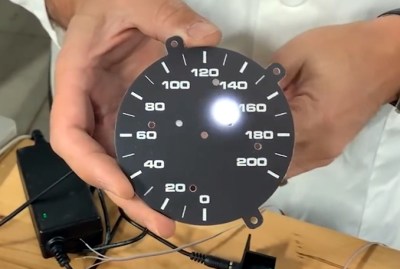We’ve seen several so-called “digital dash” upgrades over the years that either augment, or completely replace, a vehicle’s original dashboard indicators with new displays. Whether its seven segment LEDs or a full-on graphical interface powered by the Raspberry Pi, the end result is the same: a dashboard that looks wildly different than it did when the car rolled off the assembly line.
But this LED dashboard project from [Flyin’ Miata] takes a slightly different approach. Rather than replace the analog gauges entirely, rings of RGB LEDs of the same diameter were placed behind their matte black faces. When the LEDs are off you’d never notice them, but once they kick on, the light is clearly visible through the material.

So far, it looks like most of the work seems to have been put into the tachometer. The firmware running on the CAN equipped Adafruit Feather M4 can do things such as light up a dynamic redline based on current engine temperature. It will also light up the LEDs to follow the analog gauge as it moves around, which might not have much practical application, but certainly looks cool.
On the speedometer side, the LEDs seem to be used primarily as warning indicators. As demonstrated in the video below, the whole gauge can light up bright red to indicate a critical situation such as low oil pressure. If you wanted to, the system could also be configured with different colors corresponding to various possible fault conditions.
Compared to some of the more aggressive dashboard updates we’ve seen, this is an interesting compromise that helps retain the look of the original instrumentation. Of course, depending on the make and model of the car, you might be able to sneak in a small LCD screen without anyone noticing.
[Thanks to STR-Alorman for the tip.]

















So I’m the only one obsessed with CRTs in dashboard.
Cool.
When I was at college I had an old Mini that I installed a small 12v black and white CRT in. Had grand plans but ended up just playing my NES on it haha
Its funny who he do soundeffects when he change the dial.
I didn’t realize I was doing that until I watched the video :)
This is my project. Not mentioned in the article is a little friction circle indicator that’s built into the speedometer – it shows the direction and magnitude of acceleration so you can judge how well you’re using available traction. It’s mentioned more in the first video that Alphatek linked.
It’s not a complex project compared to some we’ve seen here, but I’ve learned a bunch of stuff about motor control and Python and microprocessors as part of it. Thanks for the feature!
Any plants on open sourcing that? I’d like to build something similar and it would be nice to see a description of what components you used and the source code.
Plans, yes. Actual progress towards those plans, not yet. I’ve been too busy tweaking, you know how it is. It’s pretty close to a stable point, I’ll do a project writeup for Hackaday with all the components.
Better video (more about the make-up of the dials) – https://www.youtube.com/watch?v=HWPH27aM02o
The install of this gauge looks really nice. It reminded me of the Steath TDI gauge that used a very similar concept back in the 2006 timeframe for mostly VW/Audi cars. The Stealth gauge install drilled out the faceplate to install the LEDs (instead of shining through). I had some conversations with the vendor, really nice guy. I found some good information on the wayback machine, including a pre-youtube video:
https://web.archive.org/web/20070216055810/http://www.impconcepts.com/generic20psiboostgaugeforsale.htm
Try to do it with new electronics and cyber security